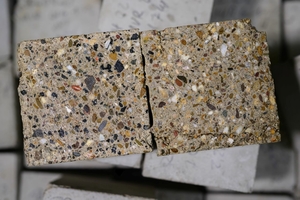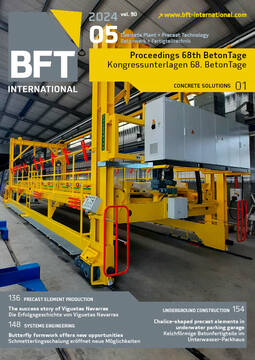Concrete with processed waste-incineration ash
In Germany, around 5.7 million tons of municipal incinerator bottom ash (HMVA) are discharged annually. For reasons of sustainability, it is the goal of the ASHCON project, funded by the German Federal Ministry of Educational Research (BMBF), to separate the mineral content of this ash by means of new treatment systems, to characterize it via neutron activation analysis and to use it in standard mix designs as substitute for natural aggregate of particle size 2/8 mm for ready-mixed concrete and for cast stone.
At the Leppe Waste Disposal Center in Lindlar-Remshagen, Germany, samples of incinerator bottom ash were taken from the landfill site as well as from “fresh” deliveries from the waste incineration facilities. After electrodynamic fragmentation at Fraunhofer IBP, and after obtaining a mineral fraction of 2 to 8 mm particle size by sorting and recycling processes, the material designated as incinerator bottom ash residue (MVR) was used in concretes as partial substitute for natural aggregate (gravel) (Fig. 1,).
The concrete samples investigated at the Cologne University of Applied Sciences varied in MVR content of the coarse aggregate (up to 75 %), origin of the MVR and/or HMVA as well as in type of cement. In these investigations of the properties of the construction materials, the focus was on processability and compressive strength. The geometrical, mechanical and chemical properties of the MVR samples turned out to be highly uniform, which was reflected in the relatively high uniformity of the properties of the fresh and hardened concrete. With consideration taken of the water absorption of the MVR, it was possible to technologically manage the properties of spread resulting from the MVR residue by adjusting them with admixtures for concrete. It was likewise readily possible to accurately employ the MVR residue samples in large-scale facilities in the ready-mix concrete industry.
Currently, investigation is still underway for properties including the following: durability to ASR and frost, environmental compatibility and large-scale implementation during production of ready-mixed concrete and cast stone.





